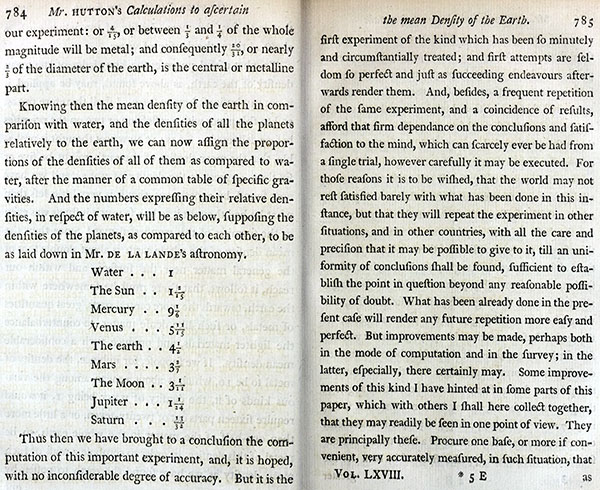### TL;DR
This paper is the proposal of the Schiehallion experim...
This idea was set out by Newton in the 3rd book of his Principia, w...
The Chimborazo attempt in 1749 was insufficiently prepared:
- In...
After a lengthy search for the perfect mountain to conduct the expe...
Here's a diagram illustrating the procedure for the experiment.
!...
Maskelyne is talking about reusing a 10' zenith telescope he operat...
The Royal Society is collaborating with JSTOR to digitize, preserve, and extend access to
Philosophical Transactions (1683-1775).
www.jstor.org
®
This idea was set out by Newton in the 3rd book of his Principia, where he showed that all 3 of Kepler's laws were the consequence of the inverse square law of gravitational attraction. Newton gave an example of a hemispherical mountain 3 mi high and 6 mi broad which he said would deflect a pendulum 1' 18''.
### TL;DR
This paper is the proposal of the Schiehallion experiment by the fifth British Astronomer Royal: Nevil Maskelyne (1732–1811)

In 1772, Maskelyne proposed an experiment to determine the mean density of the Earth. Funded by a grant from the Royal Society, it was conducted in 1774 around the Scottish mountain of Schiehallion, Perthshire.
The experiment involved measuring the tiny deflection of the vertical due to the gravitational attraction of a nearby mountain. Schiehallion was considered the ideal location after a search for candidate mountains, thanks to its isolation and almost symmetrical shape.
The Chimborazo attempt in 1749 was insufficiently prepared:
- Instruments were not good enough
- Harsh weather conditions at 15,000 feet made it very hard to work
As a consequence, the French astronomer Bouguer didn't pay too much attention to the 8'' deviation. He hoped this experiment would get attention and motivate France or England to find a more suitable mountain on which a similar experiment could be performed.
Maskelyne is talking about reusing a 10' zenith telescope he operated to observe transits of Venus at St Helena in 1761. In this case, getting financial aid to do the experiment wasn't a problem since his Majesty King George the Third had already allocated funds for the observations of transits of Venus and allowed that unspent balance to be used for this new astronomical experiment.

After a lengthy search for the perfect mountain to conduct the experiment over the summer of 1773, Maskelyne ended up choosing Schiehallion instead of Whernside or Blencathra-Skiddaw. Schiehallion is a 1,083 m (3,553 ft) peak lying between Loch Tay and Loch Rannoch in the central Scottish Highlands. It stood in isolation from any nearby hills, which would reduce their gravitational influence, and its symmetrical East–West ridge would simplify the calculations. Its steep northern and southern slopes would allow the experiment to be sited close to its centre of mass, maximising the deflection effect. Coincidentally, the summit lies almost exactly at the latitudinal and longitudinal centre of Scotland.

Here's a diagram illustrating the procedure for the experiment.

The 2 forces acting on the plumb-bob are given by Newton's law of gravitation: $F_1$- Earth's attraction force and $F_2$ - the mountain's attraction force.
Under equilibrium, the vertical component of the pendulum tension $T$ has to be the same as $F_1$ and the horizontal component equals $F_2$.
$$
T \cos \theta = \frac{GmM_E}{r_E^2} \\
T \sin \theta = \frac{GmM_M}{d^2}
$$
Joining the equations above we get
$$
\tan \theta = \frac{\rho_M}{\rho_E}\frac{V_M}{V_E}\left(\frac{r_E}{d}\right)^2
$$
Since $V_E, V_M, r_E$ and $d$ are known, by measuring $\theta$, the ratio of Earth's and the mountain's density can be calculated
$$
\frac{\rho_E}{\rho_M}= \frac{V_M}{V_E}\left(\frac{r_E}{d}\right)^2\frac{1}{\tan \theta}
$$
The mathematician and surveyor Charles Hutton was charged with doing the detailed calculations of the result. He published them in a 100-page paper in 1778.
His final conclusion was that the density of the Earth was 1.8 times the density of the quartzite in Schiehallion, or about 4.5 g/$cm^3$. Since this was so much higher than the densities of various types of rock (typically between 2 and 3 g/$cm^3$), Hutton concluded that much of the core of the Earth must be metal, and he calculated that about 65% of the Earth’s diameter must be a metallic core (a little higher than current measurements of 55%).
This was also the very first time that we had any estimate of the density/mass of the Earth, and Hutton also used it to calculate the densities of the Sun, the Moon, and the planets (out to Saturn) based on their known astronomical properties, mostly to within about 20% of the modern values. So the Schiehallion experiment was groundbreaking and significantly increased our fundamental understanding of the Earth and the solar system.
